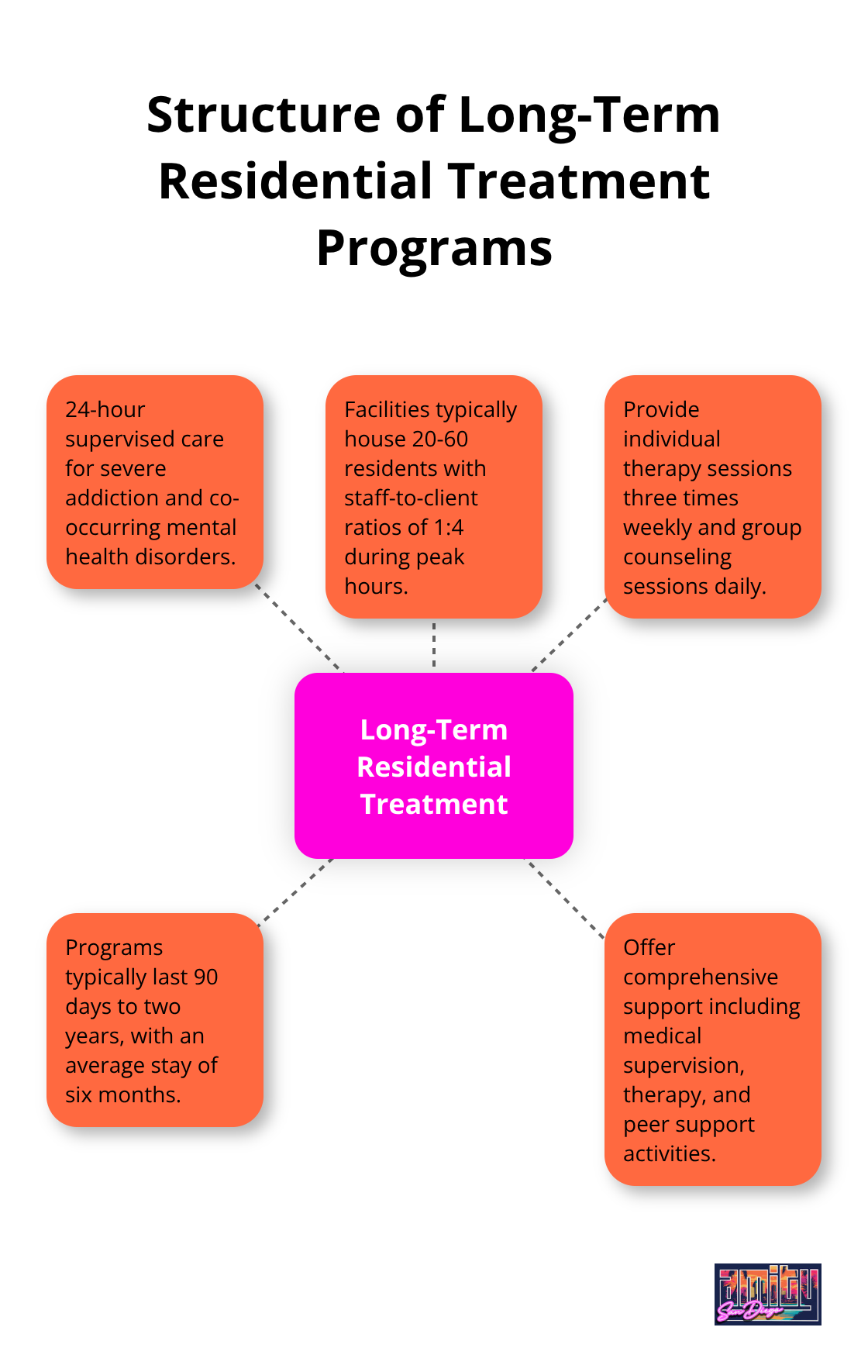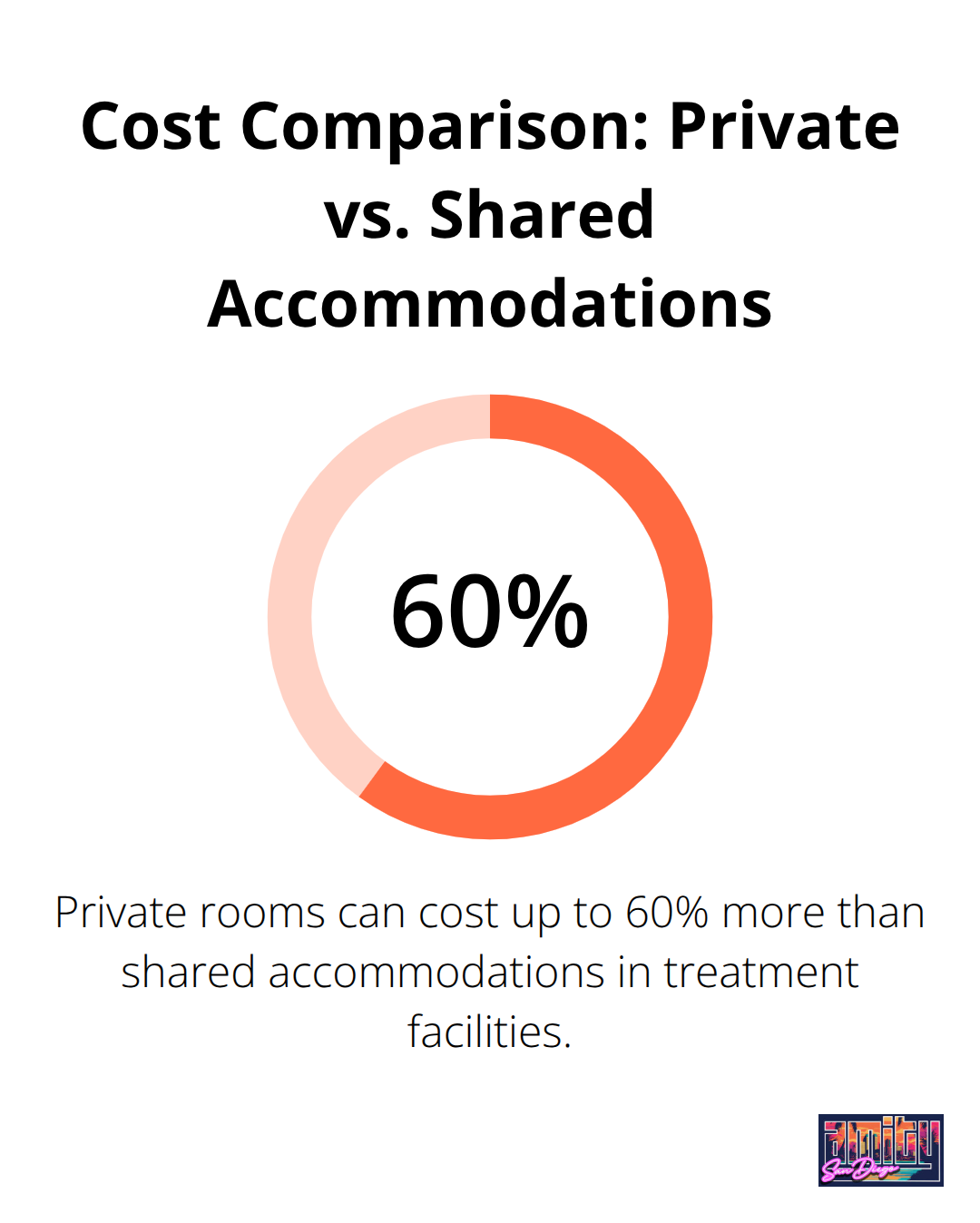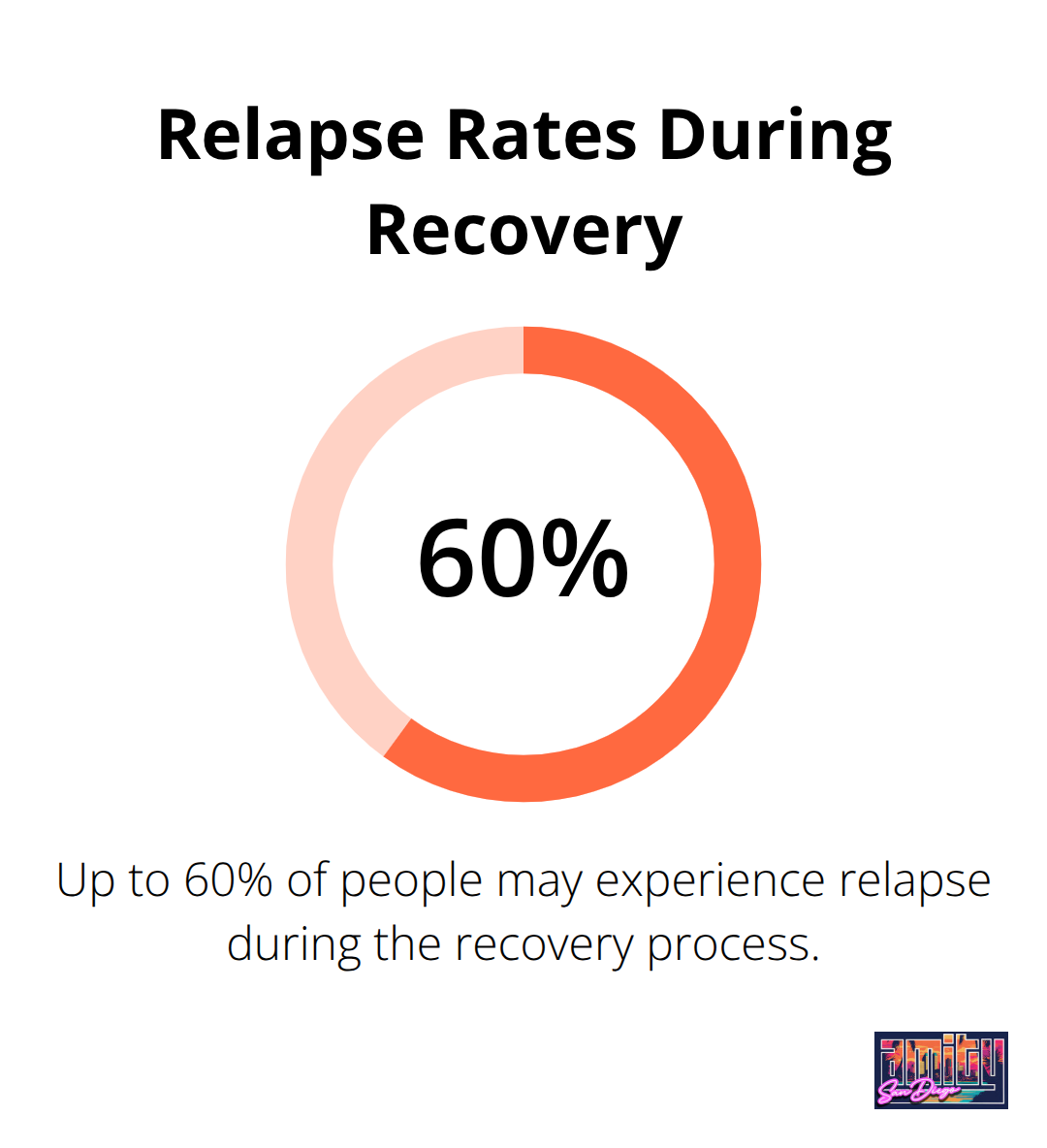Finding the right long-term residential treatment programs can feel overwhelming when you’re facing addiction. The decision affects not just recovery outcomes, but your entire future.
We at Amity San Diego understand that choosing quality care requires knowing what to look for. This guide breaks down the essential factors that separate effective programs from those that fall short.
What Is Long-Term Residential Treatment
Long-term residential treatment programs provide 24-hour supervised care for individuals who battle severe addiction and co-occurring mental health disorders. These programs typically last 90 days to two years, offering comprehensive support for recovery. Most facilities house 20-60 residents and maintain staff-to-client ratios of 1:4 during peak hours, providing intensive medical supervision, individual therapy sessions three times weekly, and group counseling sessions daily.

Duration and Program Structure
Programs range from 90 days to two years, with the average stay lasting six months. Research consistently shows that longer treatment episodes predict better outcomes. The 90-day minimum exists because the brain needs time to heal from addiction’s neurological damage. Facilities structure days around therapy sessions, medical appointments, educational workshops, and peer support activities. Most programs divide treatment into phases: stabilization (first 30 days), intensive therapy (days 31-90), and transition preparation (beyond 90 days).
Evidence-Based Treatment Methods
Effective programs focus on cognitive-behavioral therapy, dialectical behavior therapy, and trauma-informed care rather than outdated confrontational methods. Therapeutic communities emphasize peer accountability and structured daily routines, while medical model facilities prioritize psychiatric medication management and clinical interventions. The most effective programs combine both approaches and address addiction alongside mental health conditions like depression, anxiety, and PTSD. Integrated treatment for comorbidity has been found to be consistently superior compared to treatment of individual disorders with separate treatment plans.
Ideal Candidates for Residential Care
Individuals with multiple failed outpatient attempts, severe polysubstance use, or unstable housing situations benefit most from residential programs. Those with co-occurring disorders (particularly bipolar disorder or severe depression) require the intensive medical monitoring that only residential settings provide. People with histories of multiple hospitalizations, chronic relapse patterns, or suicidal ideation need this level of care. The structured environment removes triggers and provides the foundation necessary before individuals can transition to less intensive addiction treatment San Diego programs.
Key Factors to Consider When Choosing a Program
Accreditation from the Joint Commission or Commission on Accreditation of Rehabilitation Facilities serves as your primary quality indicator. These organizations conduct rigorous on-site evaluations every three years and examine everything from medication protocols to staff records. State licenses provide basic regulatory compliance, but accredited facilities demonstrate commitment to excellence beyond minimum requirements. The Joint Commission surveys many types of organizations under behavioral health care standards, including mental health services and addiction treatment. Programs without proper accreditation often lack standardized protocols, maintain inadequate documentation systems, and provide subpar clinical oversight that can compromise your safety.
Staff Credentials and Treatment Philosophy
Licensed clinical staff should include board-certified addiction medicine physicians, licensed clinical social workers, and certified addiction counselors with master’s degrees minimum. Patient-to-staff ratios during peak hours should not exceed 8:1 for group therapy and 12:1 for general supervision. Programs that emphasize cognitive-behavioral therapy, dialectical behavior therapy, and motivational enhancement show superior outcomes compared to confrontational models. Several therapies are used during addiction treatment to help people recover from substance use disorders when evidence-based methods are used consistently. Programs that promote unproven methods like rapid detox or excessive use of alternative therapies without clinical backing should raise immediate concerns.
Insurance Coverage and Financial Transparency
Insurance coverage varies dramatically between programs, with some facilities accepting only private pay while others work with major carriers. Verify benefits before admission and request written estimates that include potential additional costs. Most reputable programs provide detailed breakdowns of daily rates, therapy fees, and medication costs upfront. Private rooms cost 40-60% more than shared accommodations but provide better sleep quality and reduced stress levels during early recovery phases. Programs that refuse to discuss costs or provide vague estimates often hide additional fees that surface during treatment.

Location and Family Involvement Balance
Distance from home environments can reduce exposure to familiar triggers, but family involvement decreases significantly with distance. Weekly family therapy sessions and regular communication policies become essential when you choose distant facilities. Local programs allow for easier family participation but may expose you to familiar triggers and social pressures. The most effective approach balances distance from negative influences with accessibility for supportive relationships. These location considerations will directly impact your ability to identify and avoid potential warning signs in treatment facilities. For comprehensive addiction treatment San Diego options, consider programs that maintain this crucial balance.
Red Flags to Avoid in Residential Treatment Centers
Facilities that operate without Joint Commission or CARF accreditation present serious safety risks that can derail your recovery. Programs without proper accreditation often lack standardized medication protocols, maintain inadequate clinical documentation, and employ unqualified staff who cannot provide appropriate crisis intervention. State licenses provide only basic regulatory compliance, while accredited facilities undergo rigorous three-year evaluations that examine everything from treatment protocols to staff qualifications. The Joint Commission maintains strict standards for behavioral health programs and requires specific staff-to-patient ratios and evidence-based treatment protocols that unaccredited facilities often ignore.
Unrealistic Marketing Claims
Treatment centers that promise guaranteed success rates or claim 90% cure rates exploit vulnerable individuals who seek hope. Legitimate programs acknowledge that addiction recovery involves ongoing management rather than permanent cures (the National Institute on Drug Abuse reports that 40-60% of people experience relapse during recovery). Facilities that advertise luxury amenities over clinical excellence prioritize profits over patient outcomes. Programs that pressure immediate enrollment without facility tours or family consultations demonstrate concerning business practices.

High Staff Turnover and Poor Reviews
Staff turnover rates that exceed 30% annually indicate poor management and unstable treatment environments that compromise continuity of care. Online review patterns that show multiple one-star ratings cite poor medical care, inadequate staffing, or billing disputes and should raise immediate red flags about program quality and patient satisfaction. Programs with consistent complaints about staff inexperience or frequent counselor changes cannot provide the stable therapeutic relationships necessary for effective treatment.
Restricted Communication Policies
Programs that restrict family communication to scheduled weekly calls or prohibit unannounced visits often hide substandard conditions or treatment practices. Effective residential programs encourage family involvement through regular therapy sessions, educational workshops, and transparent communication policies that build trust. Facilities that discourage family questions about treatment progress or refuse to provide detailed treatment plans demonstrate concerning transparency issues.
Inadequate Medical and Mental Health Services
Facilities without 24-hour medical staff or those that rely solely on on-call physicians cannot provide adequate care for medical emergencies or withdrawal complications. Programs that lack psychiatric services or discourage prescribed medications create dangerous situations for individuals with co-occurring mental health disorders who require ongoing medication management. Treatment centers that promise to cure mental health conditions through addiction treatment San Diego alone ignore the complex nature of dual diagnosis care.
Final Thoughts
Effective long-term residential treatment programs require careful evaluation of accreditation status, staff qualifications, and evidence-based treatment approaches. Programs with Joint Commission or CARF accreditation, licensed clinical staff, and transparent communication policies provide the foundation for successful recovery outcomes. Research extends beyond online reviews to include facility visits, insurance verification, and detailed discussions with clinical staff about treatment philosophies.
Programs that combine medical supervision with therapeutic interventions while maintaining appropriate staff-to-patient ratios offer the comprehensive care necessary for lasting recovery. The transition from residential care to outpatient services marks a critical phase in recovery (this phase requires specialized support to maintain progress). We at Amity San Diego provide outpatient programs that support individuals who move from residential treatment through our services.
Quality long-term residential treatment programs create the foundation for lifelong recovery success. The investment in proper residential treatment makes the difference between temporary sobriety and lasting transformation. Contact us today to learn how our addiction treatment San Diego programs can support your recovery journey.

